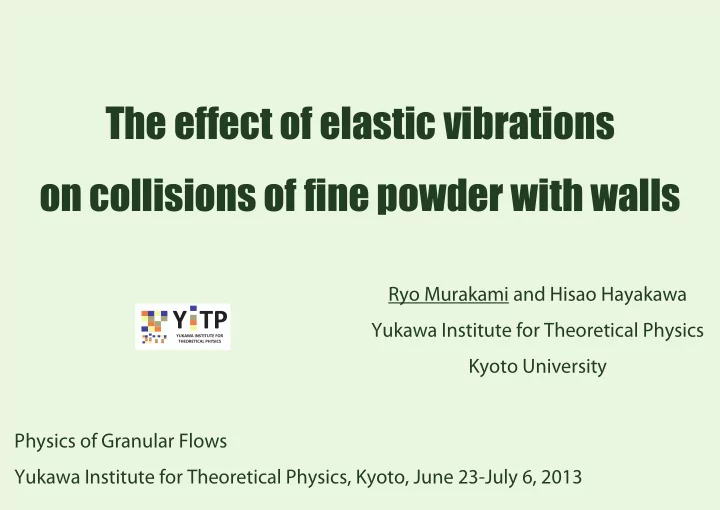

The effect of elastic vibrations on collisions of fine powder with walls Ryo Murakami and Hisao Hayakawa Yukawa Institute for Theoretical Physics Kyoto University Physics of Granular Flows Yukawa Institute for Theoretical Physics, Kyoto, June 23-July 6, 2013
Contents Introduction Recent experiments and simulations of collisions of granular particles Model The elastic wave equation and the wall potential Results The energy stored in the vibration is transformed into translational energy. Discussion Perturbation theory Conclusion
Introduction
Collisions of Granular Particles Restitution Coefficient Nonlinear function Vibration : store and release
Collisions of Granular Particles Experiment Restitution Coefficient F. Müller, M. Heckel, A. Sack and T. Pöschel, Phys. Rev. Lett. 110, 254301 (2013). Nonlinear function steel, 6mm Vibration : store and release Glass 40 cm
! Super Rebounds Molecular Dynamics Super Rebounds Breaking the second law? H. Kuninaka and H. Hayakawa, Phys. Rev. E 79, 031309 (2009).
Two Approaches Molecular Dynamics Continuum Model System Many-Particle Continuum Focus on Microscopic structures Macroscopic motions Computational Depending on the size Independent of the size Cost larger than 100 nm H. Kuninaka and H. Hayakawa, PRE 86, 051302 (2012)
◯ × × ◯ Previous Studies Previous Studies Our Study F. Gerl and A. Zippelius, Phys. Rev. E 59, 2361 (1999). H. Hayakawa and H. Kuninaka, Chem. Eng. Sci. 57, 239 (2002). Dimension 2D 3D Impact Fast Ultra-slow Velocity ~ Sound velocity / 10 ~ Thermal velocity Attraction Viscosity Collision with Wall, ball Wall
Model
Elastic Wave Equation Elastic Wave Equation Divergence term Rotation term : Vertical sound velocity : Horizontal sound velocity
Elastic Wave Equation Dipole Elastic Wave Equation Divergence term Rotation term : Vertical sound velocity Stress Free Solutions : Horizontal sound velocity Spheroidal modes Breathing Quadrupole : Principal quantum number : Azimuthal quantum number : Magnetic quantum number
Elastic Wave Equation Dipole Elastic Wave Equation Divergence term Rotation term : Vertical sound velocity Stress Free Solutions : Horizontal sound velocity Spheroidal modes Breathing Quadrupole : Principal quantum number : Azimuthal quantum number : Magnetic quantum number Torsional modes No contribution in head-on collisions Neglected
Wall Potential Equation of motion : Mass density : Mass Wall Potential Modified Lennard-Jones A. Awasthi et al., Phys. Rev. B 76, 115437 (2007). : Number density : Cohesive parameter : borrow from copper P. M. Agrawal et al. , Surf. Sci. 515, 21 (2002).
Wall Potential Equation of motion : Mass density : Mass Wall Potential Modified Lennard-Jones A. Awasthi et al., Phys. Rev. B 76, 115437 (2007). : Number density : Cohesive parameter : borrow from copper P. M. Agrawal et al. , Surf. Sci. 515, 21 (2002). Center of mass
Initial Conditions Center of Mass Fix : at the position V = 0 Control : 0.0001 ~ 0.1 sound velocity Distribution of vibrational modes Using normal random number
Results
Restitution Coefficient vs Impact Velocity Cohesive Parameter 1 0.99 : No reduce 0.98 0.97 Temperature e 0.96 0.95 R = 1 µ m 0.94 R = 100 nm 0.93 0.0001 0.001 0.01 0.1 v 0 / c (t)
Restitution Coefficient vs Impact Velocity 1 Cohesive Parameter 0.998 0.996 0.994 0.992 0.99 e Temperature 0.988 0.986 0.984 R = 1 µ m 0.982 R = 100 nm 0.98 1e-06 1e-05 0.0001 0.001 0.01 0.1 v 0 / c (t)
Restitution Coefficient vs Impact Velocity 1 Cohesive Parameter 0.995 0.99 0.985 0.98 e Temperature 0.975 0.97 0.965 0.96 R = 1 µ m 0.955 1e-06 1e-05 0.0001 0.001 0.01 v 0 / c (t)
Restitution Coefficient vs Impact Velocity 1.015 Cohesive Parameter 1.01 1.005 1 e Temperature 0.995 0.99 0.985 R = 100 nm 0.98 0.0001 0.001 0.01 v 0 / c (t)
Excitation Energy : Excitation energy of each mode : Initial kinetic energy Cohesive Parameter 0.008 R = 100 nm, v 0 = 0.0001c (t) 0.007 0.006 0.005 ∆ H nlm / H 0 Temperature 0.004 0.003 0.002 0.001 0 -0.001 0 500 1000 1500 i = (n, l, m)
Excitation Energy : Excitation energy of each mode : Initial kinetic energy Cohesive Parameter 0.008 R = 100 nm, v 0 = 0.0001c (t) 0.007 0.006 0.005 ∆ H nlm / H 0 Temperature 0.004 0.003 0.002 Quadrupole mode 0.001 0 -0.001 0 500 1000 1500 i = (n, l, m)
Restitution Coefficient vs Initial Phase : Amplitude : Phase 1.03 Cohesive Parameter 1.02 1.01 1 e 0.99 Temperature 0.98 0.97 R = 100 nm, v 0 = 0.0001c (t) 0.96 - π - π /2 0 π /2 π α 020
Discussion
Perturbation Theory Unit : Mass : Radius : Initial velocity Expansion 0th order 1th order 2th order
Perturbation vs Simulation 3.5e-05 Perturbation Simulation 3e-05 2.5e-05 ∆ H 020 / H 0 2e-05 1.5e-05 1e-05 5e-06 0 -300 -200 -100 0 100 200 300 :
Phase Dependence : Excitation energy : Initial kinetic energy Energy conservation Averaging out except :
Two Ball Collisions
0.08 Two-ball 0.07 ball-wall 0.06 0.05 force 0.04 0.03 0.02 0.01 0 -0.01 0 0.05 0.1 0.15 displacement
Conclusion Simulation Super rebounds are found when the radius, the temperature and the velocity are 100 nm, 300 K and 10-4 sound velocity, respectively. The quadrupole mode is the most excited in this condition. Sinusoidal structure is found in the restitution coefficient as a function of the initial phase of the quadrupole mode. Perturbation theory The perturbation theory is good agree with our simulation when the initial velocity is lower than 10-5 sound velocity. The sinusoidal structure of the restitution coefficient is derived using this theory.
0.0007 g = 0 0.0006 0.0005 ∆ H 000 / H 0 0.0004 0.0003 0.0002 0.0001 0 0 0.1 0.2 0.3 0.4 v 0
0.04 g = 0 0.035 0.03 ∆ H 020 / H 0 0.025 0.02 0.015 0.01 0.005 0 0 0.1 0.2 0.3 0.4 v 0
Recommend
More recommend